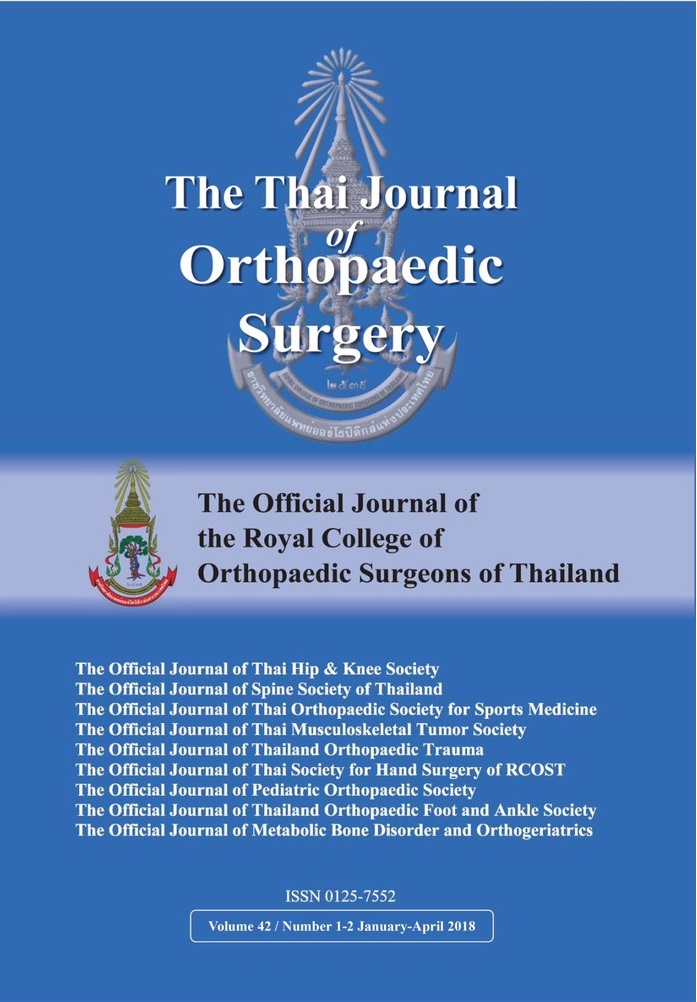A Case Report of Posterior Shoulder Dislocation with Greater Tuberosity Fracture
Main Article Content
Abstract
Purpose: Posterior shoulder dislocation with fracture of greater tuberosity of the humerus is extremely rare. Therefore, the best prescribed treatment for it has not yet been established.
Methods: A 45-year-old male, the victim of motorcycle accident, presented with shoulder injury and deformity. Post injury radiographs demonstrated a posterior shoulder dislocation and hollow glenoid with bony fragments. Computed tomographic findings revealed a posterior shoulder dislocation with fracture of greater tuberosity of the humerus. A closed reduction procedure was successfully performed under general anesthesia.
Results: Anatomical reduction of shoulder joint and greater tuberosity fragment was achieved with good joint stability.
Conclusion: Closed reduction under general anesthesia is an effective treatment for posterior dislocation with fracture of greater tuberosity.
Article Details
References
2. Matsen FA, Lippit SB, Bertlesen A, Rockowood AC, Wirth MA, Titelman RM. Glenohumeral instability. In: Rockwood CA, Matsen FA, Wirth MA, Lippitt SB, Fehringer EV, Sperling JW, editors. The Shoulder. 3rd ed. Vol. 2. Philadelphia: Saunders; 2004. pp. 655-794.
3. Mimura T, Mori K, Matsusue Y, Tanaka N, Nishi Y, Kobayashi M. Closed reduction for traumatic posterior dislocation of the shoulder using the 'lever principle': two case reports and a review of the literature. J Orthop Surg (Hong Kong) 2006; 14: 336-9.
4. Rouleau DM, Hebert-Davies J. Incidence of associated injury in posterior shoulder dislocation: systematic review of the literature. J Orthop Trauma 2012; 26: 246-51.
5. Reddy VRM. Posterior shoulder dislocation associated with acromion fracture. Eur J Orthop Surg Traumatol 2009; 19: 333-6
6. Nakae H, Endo S. Traumatic posterior dislocation of the shoulder with fracture of the acromion in a child. Arch Orthop Trauma Surg 1996; 115: 238-9
7. Goodrich JA, Crosland E, Pye J. Acromion fracture associated with posterior shoulder dislocation. J Orthop Trauma 1998; 12: 521-3.
8. Perron AD, Jones RL. Posterior shoulder dislocation: avoiding a missed diagnosis. Am J Emerg Med 2000; 18: 189-91.
9. Galanakis IA, Kontakis GM, Steriopoulos KA. Posterior dislocation of the shoulder associated with fracture of humeral anatomic neck. J Trauma 1997; 42: 1176-8.
10. Li HH, Liu SQ, Peng H. A neglected posterior fracture dislocation of the shoulder with ipsilateral distal humeral shaft fracture. J Emerg Med 2011; 41: 154-6.
11. Bloom MH, Obata WG. Diagnosis of posterior dislocation of the shoulder with use of Velpeau axillary and angle-up roentgenographic views. J Bone Joint Surg Am 1967; 49: 943-9.
12. Arndt JH, Sears AD. Posterior dislocation of the shoulder. Am J Roentgenol Radium Ther Nucl Med 1965; 94: 639-45.
13. Cisternino SJ, Rogers LF, Stufflebam BC, Kruglik GD. The trough line: a radiographic sign of the posterior shoulder dislocation. AJR Am J Roentgenol 1978; 130: 951-4.
14. Cicak N. Posterior dislocation of the shoulder. J Bone Joint Surg Br 2004; 86: 324-32.
15. Richards RH, Clarke NM. Locked posterior fracture-dislocation of the shoulder. Injury 1989; 20: 297-300.
16. Ogawa K, OgawaY, Yoshida A. Posterior fracture-dislocation of the shoulder with infraspinatus interposition: the buttonhole phenomenon. J Trauma. 1997; 43: 688-91.
17. Robinson CM, Akhtar A, Mitchell M, Beavis C. Complex posterior fracture-dislocation of the shoulder. Epidemiology, injury patterns, and results of operative treatment. J Bone Joint Surg Am 2007; 89: 1454-66.
18. Hawkins RJ, Belle RM. Posterior instability of the shoulder. Instr Course Lect 1989; 38: 211-5.


